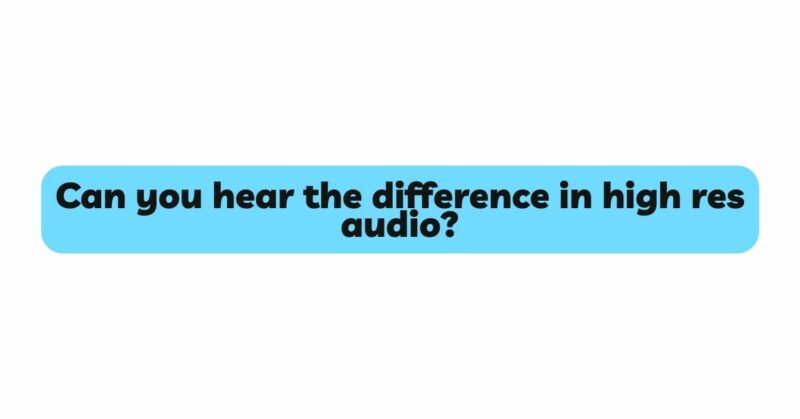The evolution of digital audio has given rise to an intriguing debate: Can you hear the difference in high-resolution audio? The allure of high-res audio lies in its promise to capture sound with unparalleled fidelity, but the question of whether listeners can genuinely perceive these heightened nuances is a topic that captivates audiophiles, music enthusiasts, and scientists alike. This article delves into the technical foundations of high-resolution audio, the intricacies of human auditory perception, scientific experiments, and the implications of this ongoing sonic exploration.
Decoding High-Resolution Audio
High-resolution audio refers to audio recordings with greater bit depths and sample rates than standard CD quality (16-bit/44.1kHz). These increased specifications aim to capture a more accurate representation of the original sound source, theoretically delivering greater fidelity and realism. Formats like FLAC, DSD (Direct Stream Digital), and MQA (Master Quality Authenticated) are embraced for their potential to preserve audio nuances.
The Complexity of Auditory Perception
Human auditory perception is a complex interplay of biology, psychology, and technology. The human ear can detect a wide range of frequencies and amplitudes, with sensitivity varying from person to person. Our brain processes auditory signals and interprets them as the rich tapestry of sound we experience.
Factors Influencing Perception
Several factors influence an individual’s ability to perceive differences in high-res audio:
- Listening Environment: The acoustic characteristics of the listening space, ambient noise, and room treatments impact the listener’s experience.
- Playback Equipment: High-res audio’s potential can be fully realized with high-quality headphones, speakers, and amplifiers that can faithfully reproduce the heightened detail.
- Listeners’ Hearing Acuity: Audiophiles and individuals with trained ears may have a greater ability to detect subtle differences due to their heightened sensitivity.
Scientific Experimentation: Can You Hear the Difference?
Scientific studies have investigated whether individuals can indeed discern differences in high-resolution audio. Double-blind listening tests, where neither the listener nor the experimenter knows the audio source, have been conducted to objectively assess listeners’ abilities. These tests often utilize various high-res and standard-resolution audio sources to determine if listeners can accurately identify differences.
Results and Interpretations
Results of listening tests have been mixed. Some studies suggest that listeners can detect subtle differences between high-res and standard audio under controlled conditions, particularly in scenarios where the audio sources differ significantly in quality. However, other studies have indicated that the perceptual distinctions might not be as pronounced as initially believed, especially in real-world listening environments.
The Role of Psychoacoustics
Psychoacoustics—the study of how humans perceive sound—plays a significant role in our understanding of high-res audio perception. Factors like masking, where louder sounds obscure softer ones, can influence the perceived differences in audio quality. Our brain’s inherent ability to fill in missing audio information can also impact how we perceive high-res audio nuances.
Subjective Experience and Expectation Bias
Subjective experience is intertwined with the perception of high-res audio. The phenomenon of expectation bias—the subconscious influence of knowing the audio source—can sway listeners’ perceptions. If listeners believe they are hearing a high-res audio source, they might be more inclined to perceive it as superior, even if the differences are subtle or non-existent.
Practical Implications
The question of whether you can hear the difference in high-res audio has practical implications:
- Music Production: High-resolution formats have gained traction in music production and mastering studios, where capturing nuanced recordings is paramount.
- Audiophile Enthusiasts: Audiophiles, equipped with high-quality gear and acoustically treated spaces, may cherish the additional details offered by high-res audio.
- Consumer Listening: For the average listener, the differences in high-res audio may be less pronounced. Everyday listening environments and devices might not fully capitalize on the increased resolution.
Conclusion: Harmonizing Perception and Reality
The question of whether you can hear the difference in high-res audio embodies the nexus of technology, perception, and personal preference. While scientific experiments hint at listeners’ potential to perceive differences, the practical relevance varies based on individual listening environments, hearing abilities, and the playback equipment employed.
The appreciation of high-res audio transcends mere auditory accuracy; it’s a blend of technological advancement, the art of music, and the emotional connection listeners share with their favorite tunes. Whether you can hear the difference is not merely a technical quandary; it’s a symphony of individual perception, psychological influence, and the awe-inspiring universe of sound that music offers.


